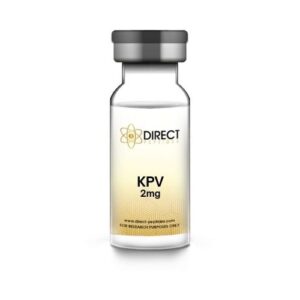In recent years, research into the Human C Peptide has revealed potential benefits far beyond its role in insulin production. Though often overshadowed by its counterpart, insulin, Human C Peptide is now gaining significant attention for its role in cardiovascular health, particularly in relation to diabetic cardiomyopathy and arrhythmias.
As we explore these connections, it’s important to note that these peptides, including Human C Peptide, are intended for research purposes only and should not be used in humans outside controlled studies.
Diabetic cardiomyopathy is a heart condition that develops due to the chronic presence of high blood sugar levels, a hallmark of diabetes. Over time, elevated blood glucose leads to changes in the structure and function of the heart muscle, making it stiffer, thicker, and less efficient at pumping blood. This condition can lead to heart failure, one of the leading causes of death in diabetic patients.
When we look at the mechanisms behind diabetic cardiomyopathy, the damage to the heart tissue is linked to oxidative stress and inflammation. Oxidative stress refers to an imbalance between free radicals (unstable molecules) and antioxidants in the body. This imbalance leads to cellular damage in tissues, including the heart muscle. Inflammation, on the other hand, triggers changes in the heart’s structure, making it less efficient.
This is where the Human C Peptide comes into play. While its exact mechanism isn’t fully understood, studies suggest that C Peptide may have a protective effect by reducing oxidative stress and inflammation in heart cells. One study found that C Peptide could help mitigate oxidative damage to the heart, preventing the kind of structural changes that are characteristic of diabetic cardiomyopathy.
Explore Human C Peptide from Direct Peptides Switzerland, a peptide that may help reduce oxidative stress and inflammation, supporting heart health in diabetic conditions.
Arrhythmias, or irregular heartbeats, are another major concern in diabetic patients. These irregular rhythms can range from minor palpitations to life-threatening conditions such as ventricular fibrillation. The heart relies on a highly organized electrical system to coordinate contractions and maintain a regular rhythm. When this system is disrupted, arrhythmias can occur.
Diabetes can cause changes to the electrical properties of the heart muscle, making it more susceptible to arrhythmias. Research into Human C Peptide has suggested that it may help stabilize these electrical signals.
By improving the electrical conductivity of heart cells, C Peptide may reduce the occurrence of arrhythmias. This could be especially beneficial in patients with diabetes, who are at a higher risk for developing these dangerous heart rhythm abnormalities.
Scientists believe that C Peptide’s ability to modulate ion channels (which help transmit electrical signals in the heart) is key to its potential in stabilizing arrhythmias. The peptide might help ensure that heart cells respond more appropriately to electrical signals, reducing the likelihood of abnormal rhythms.
Explore Peptide Supplies at Direct Peptides Switzerland for all your reconstitution requirements.
 While the Human C Peptide is gaining attention for its potential heart-protective benefits, it is not the only peptide under investigation. The vasoactive intestinal peptide (VIP) is another molecule that has shown promise in cardiovascular research. VIP is known for its ability to regulate blood flow and reduce inflammation, both of which are crucial factors in managing heart disease.
While the Human C Peptide is gaining attention for its potential heart-protective benefits, it is not the only peptide under investigation. The vasoactive intestinal peptide (VIP) is another molecule that has shown promise in cardiovascular research. VIP is known for its ability to regulate blood flow and reduce inflammation, both of which are crucial factors in managing heart disease.
In Switzerland research studies, VIP Peptide has demonstrated the ability to dilate blood vessels, improve circulation, and reduce the harmful effects of inflammation.
It works by stimulating specific receptors in blood vessels, causing them to relax and expand. This can lower blood pressure, improve oxygen delivery to tissues, and protect the heart from further damage caused by conditions such as diabetic cardiomyopathy.
The exciting part is that VIP Peptide and Human C Peptide might not be working in isolation. In fact, early studies suggest that these peptides may have synergistic effects, meaning that they work better together than alone.
For example, VIP Peptide might help improve blood flow, while Human C Peptide works to reduce oxidative stress and inflammation in the heart muscle. This combination could offer a powerful strategy for improving heart function and reducing the impact of diabetes on cardiovascular health.
Discover VIP Peptide from Direct Peptides Switzerland, a neuropeptide shown to enhance blood flow and reduce inflammation, supporting overall cardiovascular health.
At this stage, the research into Human C Peptide’s impact on the heart is still ongoing, but there have been promising findings. One study involving animal models of diabetes found that C Peptide helped reduce the structural changes in the heart associated with diabetic cardiomyopathy. The peptide appeared to protect heart cells from oxidative stress, which is a key contributor to the damage seen in these models.
Another study found that C Peptide might help restore normal electrical activity in the heart, reducing the occurrence of arrhythmias in diabetic rats. While these results are exciting, it’s essential to remember that these findings are still in the animal research phase. However, the potential for this peptide to have a significant impact on human health is clear.
As the research continues, scientists are looking to explore whether Human C Peptide could be used as a therapeutic tool for preventing or treating heart disease in diabetic patients. This could open the door to new treatment options for millions of people who suffer from both diabetes and heart conditions.
 If the promising findings from current research are confirmed, Human C Peptide could become a valuable tool in the fight against diabetic heart disease. The idea of using a peptide to reduce oxidative stress, improve heart cell function, and stabilize arrhythmias is both innovative and practical.
If the promising findings from current research are confirmed, Human C Peptide could become a valuable tool in the fight against diabetic heart disease. The idea of using a peptide to reduce oxidative stress, improve heart cell function, and stabilize arrhythmias is both innovative and practical.
For Switzerland researchers, this is an exciting opportunity to explore new avenues for treating heart disease. For patients with diabetes, it could mean fewer complications, reduced healthcare costs, and potentially longer lives. If C Peptide can be proven effective in human trials, it could change the way we approach heart disease in diabetics.
The ultimate goal of this research is to improve the quality of life for diabetic patients by reducing the burden of heart disease. Given the increasing prevalence of diabetes worldwide, this kind of research is more important than ever.
Understanding how peptides like Human C Peptide work and how they can be used to improve heart health could lead to groundbreaking therapies that make a real difference in people’s lives.
To truly appreciate the potential of Human C Peptide in cardiovascular health, it’s important to understand how this peptide works at a molecular level. What exactly is happening when Human C Peptide enters the picture?
Oxidative stress is one of the leading causes of heart damage in diabetic patients. The Human C Peptide has shown promise in reducing this stress by enhancing the body’s natural antioxidant defenses. By lowering oxidative stress, C Peptide helps protect heart cells from the kind of damage that leads to conditions like diabetic cardiomyopathy.
At the heart of this mechanism is the ability of C Peptide to interact with specific enzymes and proteins in the body. These interactions help reduce the production of harmful free radicals and increase the levels of antioxidants that protect heart cells from oxidative damage. In essence, C Peptide helps to keep the heart cells safe from the internal damage caused by chronic high blood sugar.
Inflammation is another key contributor to heart damage in diabetics. High blood sugar levels cause the release of inflammatory molecules, which lead to the thickening and stiffening of heart tissue. C Peptide has been shown to help modulate the inflammatory response in heart cells, reducing the amount of inflammation that occurs in response to high blood sugar.
Through its action on certain signaling pathways, C Peptide helps to regulate the production of inflammatory cytokines. By controlling this response, it may prevent the heart muscle from becoming stiff and less efficient. This anti-inflammatory effect is a critical part of how C Peptide helps protect the heart.
As we explore the potential benefits of Human C Peptide for heart health, especially in the context of diabetic cardiomyopathy and arrhythmias, it’s clear that this peptide holds significant promise.
While the research is still in its early stages, the findings so far indicate that Human C Peptide could play a crucial role in protecting the heart from the damaging effects of diabetes. Its ability to reduce oxidative stress, modulate inflammation, and stabilize the heart’s electrical activity makes it a compelling candidate for future therapies.
Moreover, the potential synergy between Human C Peptide and other peptides, like the VIP Peptide, could unlock even greater therapeutic benefits, offering hope for better management of heart disease in diabetic patients. These peptides may work together to improve blood flow, reduce inflammation, and protect the heart muscle from the ravages of chronic high blood sugar.
While more research is needed to confirm these findings in human trials, the excitement surrounding C Peptide’s heart-protective effects is growing. If these early results are confirmed, Human C Peptide could become a valuable tool in the fight against diabetic heart disease, offering patients better outcomes, fewer complications, and improved quality of life.
The study of Human C Peptide and other peptides in cardiovascular health is an area that deserves continued attention. With the rising global burden of diabetes and its associated complications, finding effective ways to protect the heart is more important than ever.
The promising results so far highlight the potential for a future where peptides like C Peptide play a vital role in improving heart health and reducing the impact of diabetes on cardiovascular function. As research progresses, it will be exciting to see how these peptides can be incorporated into clinical practice, offering new hope for millions of patients worldwide.
[1] Jones AG, Hattersley AT. The clinical utility of C-peptide measurement in the care of patients with diabetes. Diabet Med. 2013 Jul;30(7):803-17.
[2] Besser RE, Ludvigsson J, Jones AG, McDonald TJ, Shields BM, Knight BA, Hattersley AT. Urine C-peptide creatinine ratio is a noninvasive alternative to the mixed-meal tolerance test in children and adults with type 1 diabetes. Diabetes Care. 2011 Mar;34(3):607-9.
[3] Ekberg K, Brismar T, Johansson BL, Lindström P, Juntti-Berggren L, Norrby A, Berne C, Arnqvist HJ, Bolinder J, Wahren J. C-Peptide replacement therapy and sensory nerve function in type 1 diabetic neuropathy. Diabetes Care. 2007 Jan;30(1):71-6.
[4] Wahren J, Kallas A, Sima AA. The clinical potential of C-peptide replacement in type 1 diabetes. Diabetes. 2012 Apr;61(4):761-72.
[5] Iwasaki M, Akiba Y, Kaunitz JD. Recent advances in vasoactive intestinal peptide physiology and pathophysiology: focus on the gastrointestinal system. F1000Res. 2019 Sep 12;8:F1000 Faculty Rev-1629.
[6] Sun X, Huang Y, Zhang YL, Qiao D, Dai YC. Research advances of vasoactive intestinal peptide in the pathogenesis of ulcerative colitis by regulating interleukin-10 expression in regulatory B cells. World J Gastroenterol. 2020 Dec 28;26(48):7593-7602.
Shop ALL Peptide Nasal Sprays from Direct Peptides Switzerland today, your trusted supplier of premium clinical grade peptides online.

VIP Pre-Mixed Pen 2mg Peptide
£23.60 – £63.72Price range: £23.60 through £63.72 Select options This product has multiple variants. The options may be chosen on the product page
Human C Peptide Vial
£25.71 – £32.51Price range: £25.71 through £32.51 Select options This product has multiple variants. The options may be chosen on the product page
IGF-1 LR3 Nasal Spray
£87.41 – £169.81Price range: £87.41 through £169.81 Select options This product has multiple variants. The options may be chosen on the product page
KPV Peptide Vial
£13.64 – £22.62Price range: £13.64 through £22.62 Select options This product has multiple variants. The options may be chosen on the product pageALL CONTENT AND PRODUCT INFORMATION AVAILABLE ON THIS WEBSITE IS FOR EDUCATIONAL PURPOSES ONLY.
DISCLAIMER: These products are intended solely as a research chemical only. This classification allows for their use only for research development and laboratory studies. The information available on our Switzerland Direct Peptides website: https://switzerland.direct-peptides.com is provided for educational purposes only. These products are not for human or animal use or consumption in any manner. Handling of these products should be limited to suitably qualified professionals. They are not to be classified as a drug, food, cosmetic, or medicinal product and must not be mislabelled or used as such.